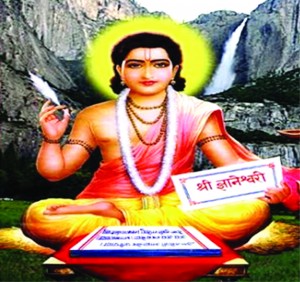Sant Gyaneshwar
This is a collection of articles archived for the excellence of their content. |
Sant Gyaneshwar
Hemant Dharmat , The greatness o f Sant Gyaneshwar "Daily Excelsior" 22/10/2017
Sant Gyaneshwar,the crown-jewel among great saints of Maharashtrawas born in 1271 at Alandi, while his ancestors hailed from Pethan. The townfinds mention in the ancient scriptures as Pratishthan. His father Vithalpant was an ascetic. Lord Krishna, the deity of Pandarpur shrine appeared in his dream and counselled him to marry Rukmani, the daughter of Sideshwar, head priest of Alandi. The latter also had a similar vision of the deity advising him to wed his daughter to Vithal pant. Though the marriage was solemnized in a matter of days, Vithalpant’s holy disposition prevented him from leading a happy married life. He proceeded on pilgrmage to Kashi,obtained ‘diksha’ from Shri Padswamiand took ‘Sanayas’.As per certain legends, Sant Ramanand whosedisciples included illustrioussaints such as Bhakt Kabir and Sant Ravi Das was also the Guru of Vithal Pant. During his sojourn in Alandi, the Guru blessed Rukmani,”Putarvati Bhav”. She said, “How can I conceive, when my husband Vithalpant has already undertaken Sanyas”. Sant Ramanand was overcome with remorse havingrealized that Vithalpant had obtained ‘diksha’ from him at Varanasi.He also recollected that Vithalpant had falsely declared himself as bachelor prior to his initiation. On his return to Kashi, he prevailed upon Vithalpant to resume conjugal relationship with Rukmani. Living in wedlock after becoming a hermit was akinto a heinous crimein the medieval period. Yet disobeying Guru’s word was considered a far bigger sin. The couple drove to penury on being widely castigated and banished from society. Meanwhile, Rukmani gave birth to three sons and a daughter. The eldest son was named Nivritti Nath, second son Gyandev (Sant Gyaneshwar), third Sopan Dev, while the fourth, a daughter was named Muktabhai. All the four siblings grew up to become eminent saints.
When Nivritti Nath was 7 years old, Vithal Pant resolvedto perform ‘Yageopaveet’ ritual for hissons. Local Brahmins blatantly refused to consecrate them and proclaimed that their parentshad incurred an ignominious sin and should, therefore, give up their life to atone for the heinous act.Vithal Pant and Rukmani embraced death by taking Jal Samadhi at Parayag. A religious gathering of learned Brahmins held at Pethan to reconsider providing ‘Shudhi Patra’ to the four children failed in their endeavour in absence of relevant ruling in scriptures. One among the learned Brahmin spoked fun at Gyaneshwar saying “Look, his name is ‘Gyan’ – true wisdom, but there is a buffalo by that name in the town”. Gyaneshwar retorted, “Verily, the same Soul pervadesme and the buffalo.” Annoyed at the reply, another Brahmin rained sticks on the buffalo.To their surprise,the stick-lashes appeared allover Gyaneshwar’s back. Someone threw another challenge, “If you and the buffalo’s soul were one, let the animal reciteVed Mantras”. Gyaneshwar tapped buffalo’s head goading it to chant the sacred verses.The august gathering was stunned to see the animal singinghymns from the Vedas and pronounced all the four kidsas chaste, on the condition that they would remain unmarried throughout their lives, so that the society could be secured from adopting immoral ways.
At Nevasa, the four siblings accosted a woman wailing over the dead body of her husband and enquired the name of the departed soul. “Sachidanand”, she uttered sorrowfully. Gyaneshwar revived the dead saying, “Sat (Truth-Pure Existence), Chit (‘Gyan’-intelligence) and Anand (Bliss) can neverperish”. Realizing difficulty faced by the common masses to comprehend Sanskrit text of Bhagwat Gita, Gyaneshwar authored the voluminous treatise in Marathi on the sacred book, known as Gyaneshwari.
The very Sachidanand jotted down the verses composed by Gyaneshwar. The work was accomplished in Mahalaya Mandir located at Nevasa, when Sant Gyaneshwar was barely 15 years old. Local sadhus became envious as his fame spread far and wide. Yogeshvar Changdev, a contemporary saint, aged 1400 yearsowing to his dexterity in Yoga and Pranayama was equally jealous. Unable to decide as to how he should address Gyaneshwar who was so young yet amazingly sagacious, he sent a blank paperto him through an emissary. When Muktabhai cast a glance at the ‘Bhojpatra’, she exclaimed, “Changdev is still blank despite his 1400 years penance”. Accompanied by his disciples, Changdev riding a lion and whipping the ferocious animal with a live venomous snake as a show off of his miraculous powers visited Sant Gyaneshwar, who was sitting on a wall along with his brothers and sister when Changdev approached. Gyaneshwar unassumingly asked the wall to move near Changdev to enable them to welcome him. On seeing the lifeless wall advancing towards him, Chagdev realized the greatness of Sant Gyaneshwar, prostrated before him and said, “Pray, show me the right path”. Gyaneshwar asked Muktabhai to give ‘Upadesh’ to Changdev.
Gyaneshwar also composed ‘Amritanubhav,”Changdev Pasaashthi’ and ‘Haripath’. He preached that the visible world was manifestation of God and the whole universean extension of the Supreme Self. Sant Gyaneshwar took Mahasamadhi on Oct 25, 1296 (Treyodashi, Kartik month Shaksamvat 1218) at the age of 25 yrs. When Gyaneshwar decided to attain Mahasamadhi, Lord Krishna, the deity of Pandarpur appeared before the assemblage of thousands of devotees.
HE adorned Gyaneshwar’s neck with a necklace bedecked with flowers, anointed his forehead with ‘Tilak’ and firmly held his hand.
Sant Nivritti Nath, the eldest brotherconsidered Gyaneshwar’s Guru for having initiated him to spirituality, grasped his other hand. Sant Namdev, a contemporary Marathi saintpurified theplace earmarked for Samadhi. As Sant Gyaneshwar shut his eyelids, Nivritti Nath closed the passage leading to the Samadhi with a rock signaling the end of a great spiritual era. Sant Namdev fainted on observing the heart-rending scene.
